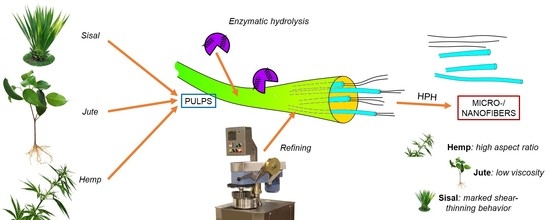Micro- and Nanofibrillated Cellulose from Annual Plant-Sourced Fibers: Comparison between Enzymatic Hydrolysis and Mechanical Refining
Abstract
Share and Cite
Aguado, R.; Tarrés, Q.; Pèlach, M.À.; Mutjé, P.; de la Fuente, E.; Sanchez-Salvador, J.L.; Negro, C.; Delgado-Aguilar, M. Micro- and Nanofibrillated Cellulose from Annual Plant-Sourced Fibers: Comparison between Enzymatic Hydrolysis and Mechanical Refining. Nanomaterials 2022, 12, 1612. https://doi.org/10.3390/nano12091612
Aguado R, Tarrés Q, Pèlach MÀ, Mutjé P, de la Fuente E, Sanchez-Salvador JL, Negro C, Delgado-Aguilar M. Micro- and Nanofibrillated Cellulose from Annual Plant-Sourced Fibers: Comparison between Enzymatic Hydrolysis and Mechanical Refining. Nanomaterials. 2022; 12(9):1612. https://doi.org/10.3390/nano12091612
Chicago/Turabian StyleAguado, Roberto, Quim Tarrés, Maria Àngels Pèlach, Pere Mutjé, Elena de la Fuente, José L. Sanchez-Salvador, Carlos Negro, and Marc Delgado-Aguilar. 2022. "Micro- and Nanofibrillated Cellulose from Annual Plant-Sourced Fibers: Comparison between Enzymatic Hydrolysis and Mechanical Refining" Nanomaterials 12, no. 9: 1612. https://doi.org/10.3390/nano12091612
APA StyleAguado, R., Tarrés, Q., Pèlach, M. À., Mutjé, P., de la Fuente, E., Sanchez-Salvador, J. L., Negro, C., & Delgado-Aguilar, M. (2022). Micro- and Nanofibrillated Cellulose from Annual Plant-Sourced Fibers: Comparison between Enzymatic Hydrolysis and Mechanical Refining. Nanomaterials, 12(9), 1612. https://doi.org/10.3390/nano12091612













